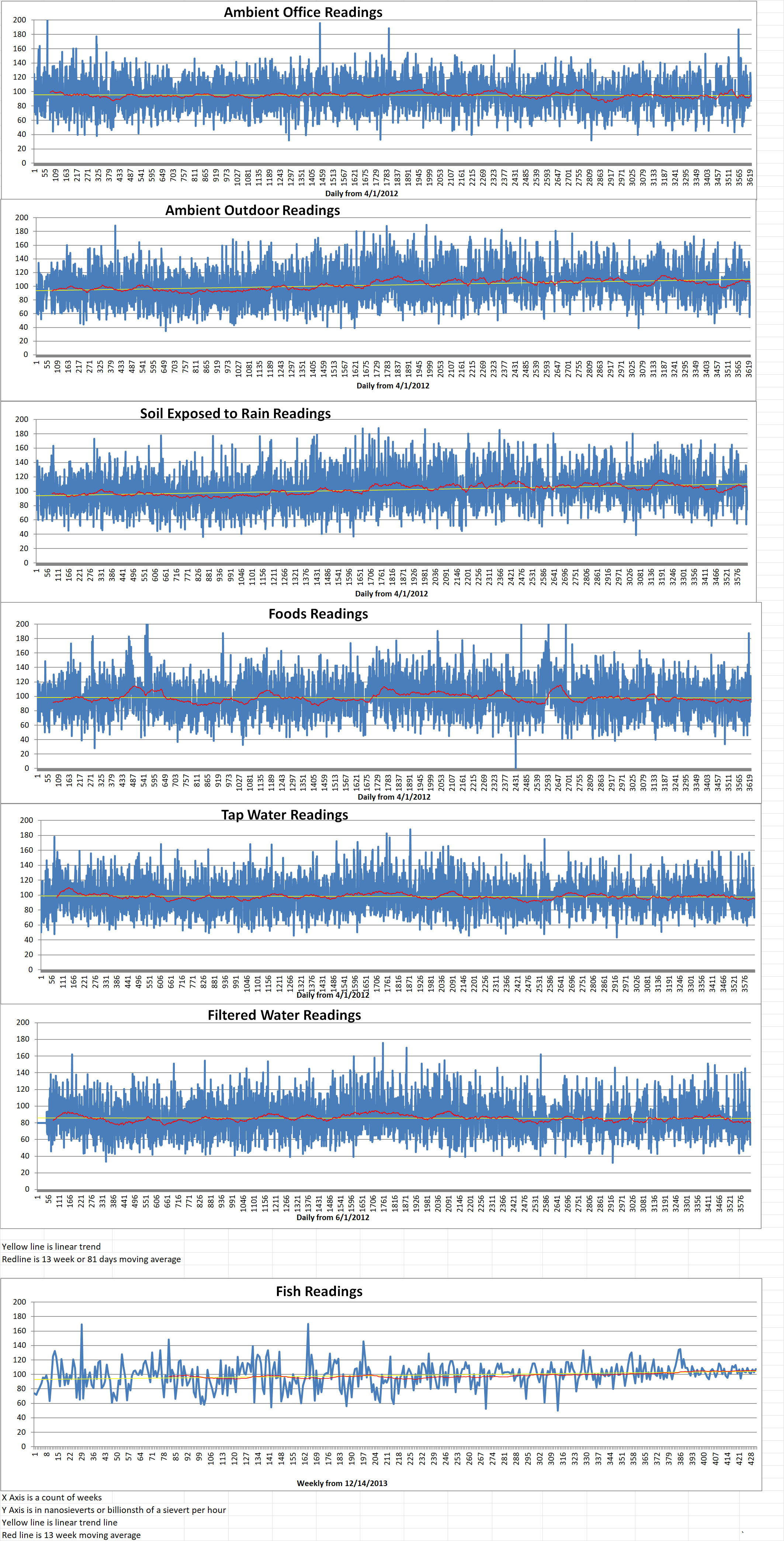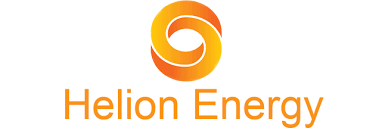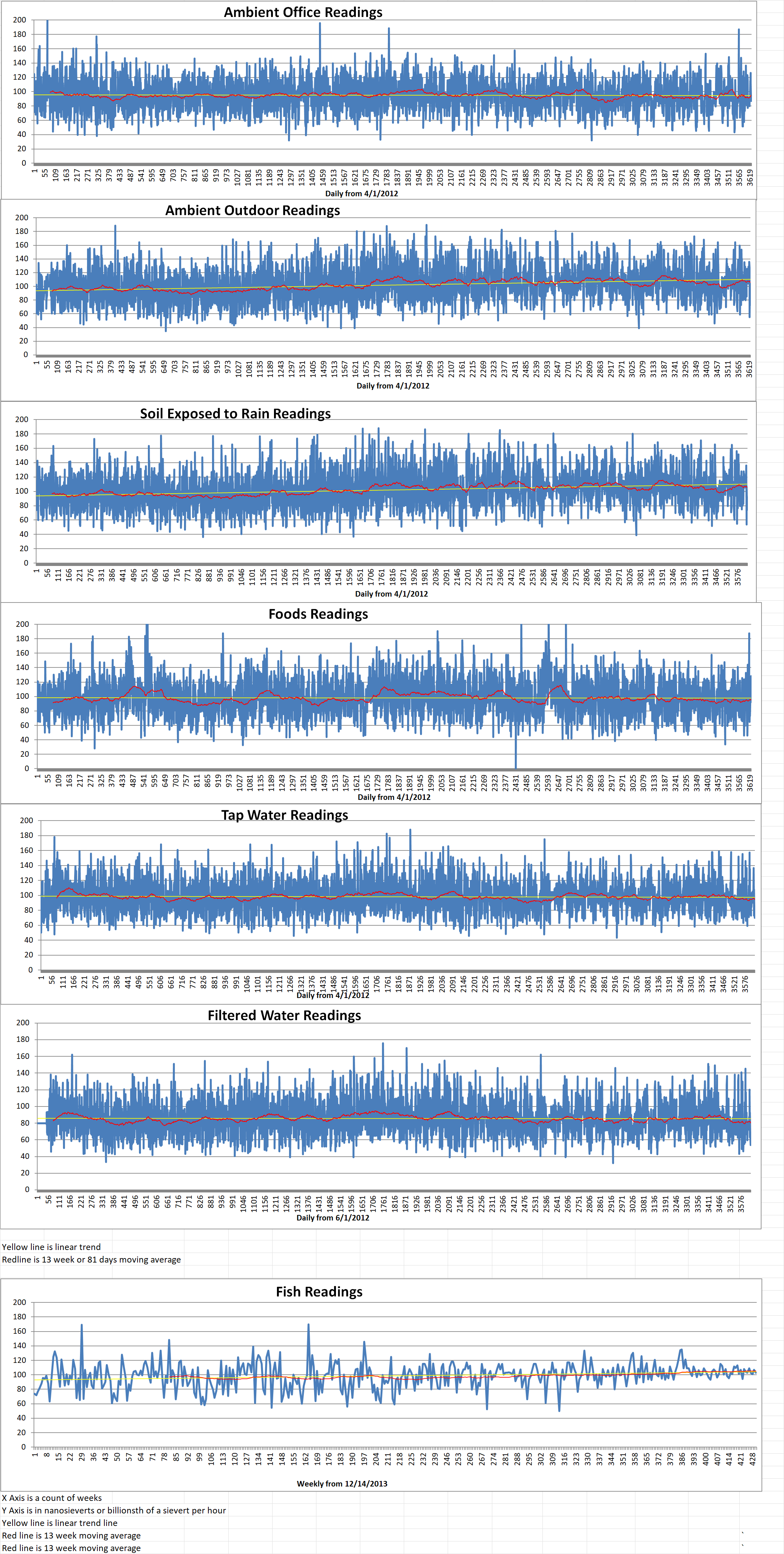Blog
-
Nuclear News Roundup June 05, 2022
The tiny number of nukes needed for ‘unacceptable damage’ express.co.uk
Toshiba and Bechtel Team-up to Support Poland’s First Nuclear Power Station businesswire.com
Study examines option for floating nuclear power in Vietnam world-nuclear-news.org
Nuclear operators to benefit from immersive 3D simulations rld-nuclear-news.org
-

Geiger Readings for June 05, 2022
Ambient office = 84 nanosieverts per hour
Ambient outside = 85 nanosieverts per hour
Soil exposed to rain water = 82 nanosieverts per hour
English cucumbers from Central Market = 123 nanosieverts per hour
Tap water = 75 nanosieverts per hour
Filter water = 67 nanosieverts per hour
-
Nuclear News Roundup June 04, 2022
NNL makes breakthrough in production of Lead-212 neimagazine.com
US warns of ‘swift and forceful’ response to North Korean nuclear test nknews.org
India tests nuclear-capable Agni-IV ballistic missile timesofindia.indiatimes.com
Finnish fuel encapsulation plant enters installation phase world-nuclear-news.org
-

Geiger Readings for June 04, 2022
Ambient office = 96 nanosieverts per hour
Ambient outside = 100 nanosieverts per hour
Soil exposed to rain water = 101 nanosieverts per hour
Blueberry from Central Market = 102 nanosieverts per hour
Tap water = 102 nanosieverts per hour
Filter water = 80 nanosieverts per hour
Dover sole = 107 nanosieverts per hour
-

Nuclear Fusion 182 – Problems With Tritium Supply For Tokamak Fusion – Part 3 of 3 Parts
Part 3 of 3 Parts (Please read Parts 1 and 2 first)
There are other ways of creating lithium-6 such as actively inserting breeding materials into nuclear fission reactors or firing neutrons at helium-3 targets using a linear accelerator. Unfortunately, these techniques are too expensive to be used in the quantity needed for commercial fusion reactors. They will be used for nuclear weapons production. The best route to commercial fusion would be to launch a more ambitious program for developing breeding technology in parallel to ITER. This way, there may be sufficient tritium being produced to fuel ITER when it is switched on in 2035. Willms said, “We don’t want to get the car built and then run out of gas.”
The tritium problem is fueling skepticism of ITER and D-T fusion projects in general. These two isotopes of hydrogen were chosen because they fuse at a relatively low temperature. This made sense in the early days of fusion research. However, with help of AI-controlled magnets to help confine the fusion reaction as well as advances in materials science, some companies are exploring alternatives.
TAE Technologies is based in California. They are attempting to build a fusion reactor that uses hydrogen and boron. They say that it will be a cleaner and more practical alternative to D-T fusion. TAE intends to reach a net energy gain where a fusion reactor creates more power than it consumes by 2025. Boron can be extracted from seawater by the metric ton. It has the added benefit of not irradiating the reactor as the D-T fusion reaction does. TAE Technologies CEO Michl Binderbauer said that their approach is more commercially viable to scalable fusion power than tokamaks burning D-T fuel.
Helion Energy in the Seattle area is taking a very different approach to fusion. It is an inertial confinement system as opposed to a tokamak. Tiny pellets of fuel are injected into the fusion chamber and then hit with a beam of light generated by a bank of lasers. Their fusion reactor burns deuterium and helium-3. As was mentioned above, deuterium is easy to produce from seawater. While helium-3 is very rare on Earth, it will be recycled in their reactors so supply should not be a problem. One of the benefits of their system is the fact that it does not produce neutrons which would irradiate the metal used in construction. Another benefit is that it will not require a steam turbine system to turn fusion generated energy into electricity.
The mainstream fusion community is still focusing on ITER for achieve practical fusion, in spite of the potential problems with tritium fuel. Willms said, “Fusion is really, really difficult, and anything other than deuterium-tritium is going to be 100 times more difficult. A century from now maybe we can talk about something else.”
Billions of dollars are being poured into fusion research. There are at least a dozen companies working on small fusion reactors of different designs using different fuels. Many of them intend to have commercial prototypes operating before 2030. It may very well be that ITER will be too much too late. It is possible that it will be upstaged by working fusion reactors before it is even completed. -
Nuclear News Roundup June 03, 2022
Nuclear war a real possibility if China invades Taiwan taiwannews.com
Boss Energy to restart production at Honeymoon world-nuclear-news.org
South Bohemia Nuclear Park founded world-nuclear-news.org
Montana legislative panel hears from SMR backers and bashers ans.org
-

Geiger Readings for June 03, 2022
Ambient office = 87 nanosieverts per hour
Ambient outside = 73 nanosieverts per hour
Soil exposed to rain water = 74 nanosieverts per hour
Avocado from Central Market = 92 nanosieverts per hour
Tap water = 82 nanosieverts per hour
Filter water = 61 nanosieverts per hour
-

Nuclear Fusion 181 – Problems With Tritium Supply For Tokamak Fusion – Part 2 of 3 Parts
Part 2 of 3 Parts (Please read Part 1 first)
Tritium once was a useless byproduct of nuclear fission that had to be carefully disposed of. The two major problems mentioned above have helped turn tritium into one of the most expensive substances on Earth. It now costs about thirty thousand dollars per gram. It is estimated that a working tokamak fusion reactor will need about four hundred and forty pounds of tritium a year.
To make matters worse, tritium is also required to enhance the explosive power of hydrogen bombs. Now, militaries in nations with nuclear arsenals make their own tritium. There are about twelve thousand nuclear warheads in the world. Each needs to be refreshed every twelve years with four grams of tritium. If one twelfth of the warheads are refreshed each year, that means that about nine pounds of tritium are needed each year. At 30,000 dollars per gram, this amounts to about thirty million dollars needed each year for nuclear warhead maintenance. Canada which has the bulk of the world’s tritium production capacity will not sell tritium for nonpeaceful purposes.
Paul Rutherford was a researcher at Princeton’s Plasma Physics Laboratory. In 1999, he published a paper predicting this tritium supply problem, referring to it as the “tritium window”. He said that this window was a sweet spot where the tritium supplies would peak before declining as heavy-water moderated reactors were turned off because their operational lifespans had passed. The world is currently in the Rutherford sweet spot. Unfortunately, ITER is too far behind schedule to take advantage of it. Scott Willms is the fuel cycle division leader at ITER. He said, “If ITER had been doing deuterium-tritium plasma like we planned about three years ago, everything kind of would have worked out fine. We’re hitting the peak of this tritium window roughly now.”
Researchers have known about this potential problem with tritium supplies for decades. They developed an effective solution. This solution would use nuclear fusion reactors to “breed” tritium. The fusion reactors would end up replenishing their own fuel at the same time as they burn it. Breeder technology would function by surrounding the fusion reactor with a “blanket” of lithium-6.
When a neutron escapes the reactor and hits a lithium-6 molecule in the blanket, it should produce tritium. The new tritium could then be extracted and fed back into the reaction. Stuart White is a spokesperson for the UK Atomic Energy Authority, which hosts the JET fusion project. He said, “Calculations suggest that a suitably designed breeding blanket would be capable of providing enough tritium for the power plant to be self-sufficient in fuel, with a little extra to start up new power plants.”
Originally, tritium breeding was going to be tested as part of ITER. But as the ITER construction costs rose from an initial estimate of six billion dollars to over twenty-five billion dollars, the tritium breeding was cut from the project. Willms’ job at ITER will be to manage smaller scale tests. Instead of a full-scale blanket of lithium-6 wrapped around the fusion chamber, ITER will utilize suitcase-sized samples of differently presented lithium inserted into “ports” surrounding the fusion chamber in the tokamak. Some of the tests will involve ceramic pebble beds, liquid lithium and lead lithium.
Please read Part 3 next -
Nuclear News Roundup June 02, 2022
Video shows Russian missile flying ‘critically low’ over Ukrainian nuclear power plant cnn.com
IAEA Chief Working on Mission to Russian-Held Zaporizhzhia Nuclear Plant usnews.com
North Korean building work advancing at nuclear site, IAEA says reuters.com
Grossi Expresses Concern to IAEA Board about Safeguards in Iran iaea.org
